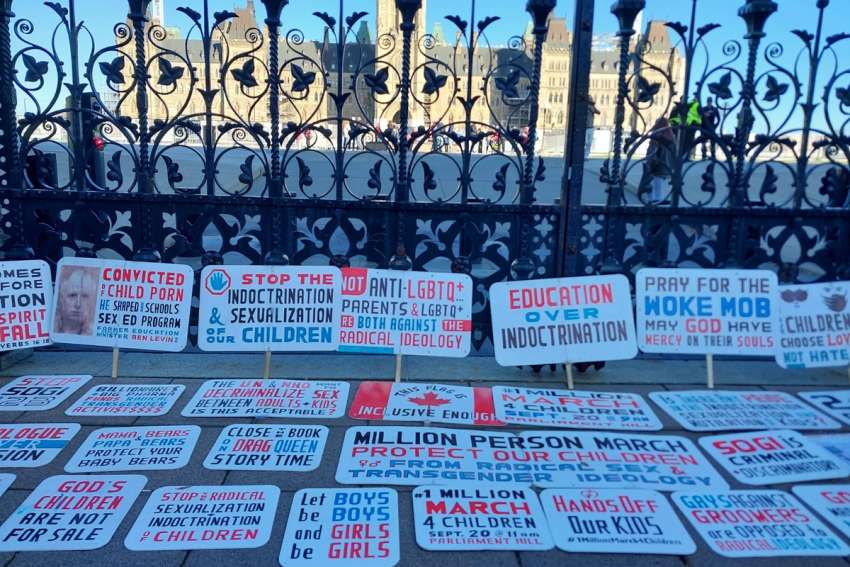There are several themes that emerge from watching the 1 Million Person March 4 Children in Ottawa on Sept. 20. Organized by Kamel El-Cheikh, an Ottawa-based Muslim father, this community was galvanized into action when a teacher in Edmonton criticized a Muslim student who had been absent for Pride activities in June. The audio recording went viral, largely because the teacher’s conclusion was that without agreement on issues of gender and sexuality, the student doesn’t belong in Canada. If that doesn’t galvanize protest, I don’t know what will. And it did.
The vibe at the protest was peaceful but loud and emphatic. As a white person, I certainly felt I was in the minority. The chants, which never died down during the march that went on a long walk of the outer edge of the parliamentary precinct, rotated between “No more silence,” and “Leave the kids alone,” with a smattering of “The people, united, will never be defeated.” I heard one other chant, but more on that in a bit.
If there is one overarching theme to emerge from witnessing the protest, it is that there are divisions between Canadians that are going to be increasingly hard to ignore.
These divisions happen in different ways. One is division between elected representatives and voters. The canned, almost robotic response from various officials even before the rally started is surprising to me, if only because this was one huge voting block marching slowly around downtown Ottawa. No matter the party, weak-kneed boilerplate responses that don’t get at the very real anxiety these parents are feeling will not suffice to diffuse this tension.
Secondly, there is a cavernous abyss between so many journalists and citizens. So much media commentary so far misses the mark about the concerns that these parent protesters have, and almost immediately seems to distort what those questions and problems truly are. This problem exacerbates tensions between Canadians. It brings heat, not light.
Thirdly, the current tensions in public education cannot hold. Kids can tell you what the Ppride flags mean, but they can’t identify the flags of the world (hey, is that the Philippines or the Czech Republic? Where is the Czech Republic?). When drag queens read stories to kids, they are not choosing classics; these are predictable, cause-based books that present pablum in lieu of advancing the important concept of tolerance. (One I reviewed recently had very little storyline at all, actually — just glitzy images). Immigrants generally place a very high value on good education (hi mom and dad!). And they aren’t getting it.
Finally, I conclude with what I see as the biggest problem but also opportunity of all: Canada relies on immigrants and we love immigrants. We have a Century Initiative that aims to see Canada grow to 100 million residents by 2100, which we are, apparently, on track to do. It’s clear that many newcomers do not view the sexuality issues as many other Canadians do and they are concerned about what public schools are teaching. In response, they get sidelined, bullied and broadly told they are intolerant or that they should “go home” as in the case of the Edmonton teacher caught on audio recording. Needless to say, we are not meeting all Canadians, and especially not newcomers, where they are at.
The last slogan I heard shouted at the march was this: “we want the Canadian flag.” There is something of note in this, something even a bit melancholy for me. What could be wrong with wanting the Canadian flag? Newcomers, who hold views many other Canadians do not, saying they want to stand under the Canadian flag, as contrasted with Pride flags. This raises a point about Pride flags that I have but rarely seen raised — they are not unifying for all. Some Canadians view them as a political statement, not the flag of openness, tolerance and love. How much longer can we avoid addressing this in a meaningful way?
I happen to have immense hope for a healthy pluralism to emerge. There are policies available for the implementing that would better serve all families than those many of our leaders currently espouse. But as a starting point, we cannot continue to pretend these divisions do not exist. Nor can we sully and cast aspersions on the motivations of either side, as seems to be the problematic norm.
These are interesting times indeed for polite and quiet Canada.
(Andrea Mrozek is senior fellow at think tank Cardus.)


